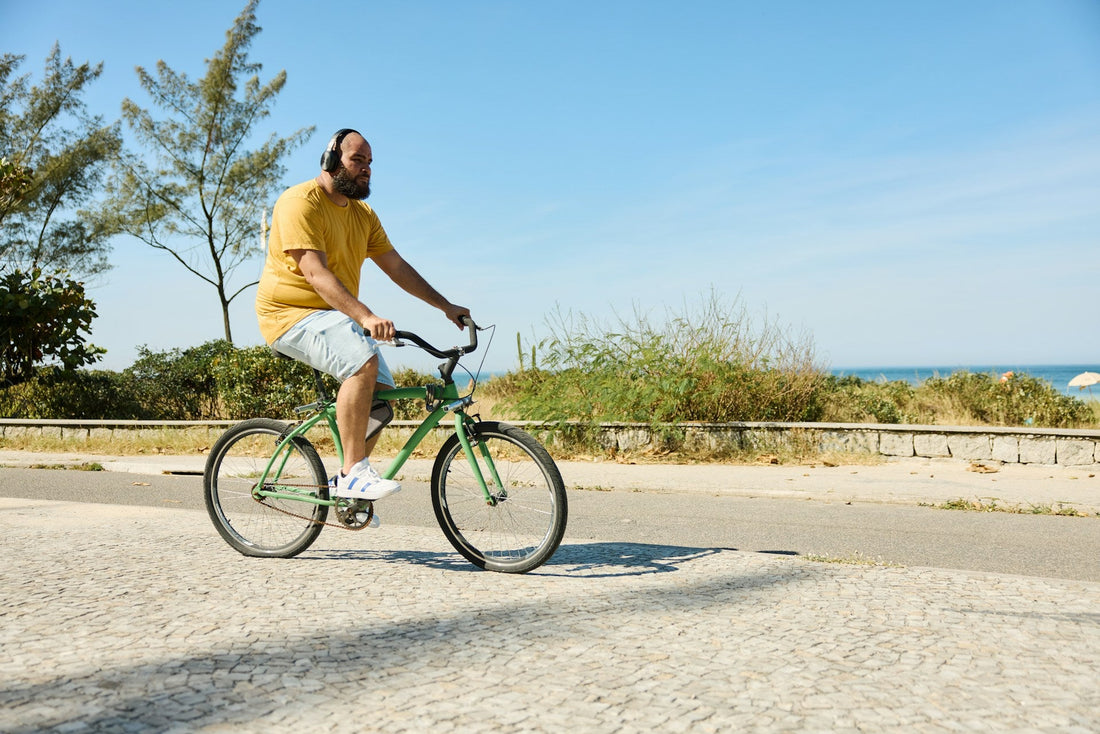
Does Riding a Bike Cause Hemorrhoids? Understanding the Connection and Prevention Strategies
Share
When it comes to the relationship between cycling and hemorrhoids, many cyclists wonder if their favorite activity is contributing to this uncomfortable condition. Riding a bike does not directly cause hemorrhoids but can aggravate existing ones due to pressure placed on the anal area and restricted circulation while sitting on a bike seat. Understanding this can help you enjoy cycling without unnecessary concern.
If you're prone to hemorrhoids, it’s essential to recognize the symptoms and take preventive measures. You can improve your cycling experience by choosing the right seat and maintaining proper posture. Additionally, staying hydrated and using topical treatments can provide relief.
For those seeking natural support, Hem Healer offers a 100% natural blend of botanical herbs designed to reduce the pain, swelling, and bleeding associated with hemorrhoids. This supplement is effective for both men and women, helping you manage symptoms while you continue to ride comfortably.
Understanding Hemorrhoids
Hemorrhoids are a common condition affecting many people. They involve swollen veins in the anal canal and can cause various symptoms ranging from discomfort to bleeding. Understanding the causes, types, and symptoms of hemorrhoids can help you manage and treat this condition effectively.
Causes and Risk Factors
Hemorrhoids occur when veins in the anal area become swollen and inflamed. Several factors can contribute to this condition. Increased pressure from straining during bowel movements is a primary cause. Chronic constipation or diarrhea can exacerbate this pressure.
Pregnancy is another significant risk factor, as the growing uterus puts additional pressure on the pelvic area. Obesity and a sedentary lifestyle can also lead to hemorrhoids. Furthermore, prolonged sitting or standing can intensify the risk, especially for cyclists who may spend extended periods on their bike seats.
Types of Hemorrhoids
Hemorrhoids are classified into two main types: internal and external. Internal hemorrhoids occur inside the anal canal and often remain painless. These can lead to bleeding during bowel movements, which may be alarming. External hemorrhoids, on the other hand, are located under the skin around the anus. They can cause pain, itching, and discomfort.
There is also a specific type known as thrombosed hemorrhoids, which occur when blood pools within an external hemorrhoid and forms a clot. This can lead to acute pain and swelling. Understanding these types can help you identify your condition better and address specific symptoms more effectively.
Common Symptoms
Symptoms of hemorrhoids can vary, but you may experience several common signs. Bleeding during bowel movements is a frequent indication, often noticeable on toilet paper or in the toilet bowl. Additionally, itching around the anus can be bothersome and occur due to irritation.
Discomfort or pain during sitting or bowel movements is another symptom that many face. In the case of thrombosed hemorrhoids, the pain can be severe. Recognizing these signs early can help you take action, such as considering remedies like Hem Healer. This supplement is designed to alleviate pain, swelling, and bleeding, making it a valuable option for anyone struggling with hemorrhoids.
The Link Between Cycling and Hemorrhoids
Cycling can contribute to certain conditions that may aggravate hemorrhoids. Understanding how bike seats, friction, and terrain impact your pelvic area is essential for managing discomfort effectively.
Bike Seats and Pelvic Pressure
The type of bicycle seat you choose plays a significant role in the pressure exerted on your pelvic area. Hard or poorly designed seats can compress sensitive veins, increasing the likelihood of discomfort and irritation. Look for seats that provide ample cushioning and support.
You can also consider adopting seat designs that distribute weight evenly. Anatomically designed bike seats that include cutouts for the perineal region can help minimize pressure on the anal area. This is vital for reducing the risk of hemorrhoid exacerbation during long rides.
Friction and Irritation
Friction during cycling can lead to chafing in the pelvic area, making hemorrhoids worse. The repetitive motion of biking, combined with tight clothing, increases skin irritation. This discomfort can aggravate existing hemorrhoids and lead to further inflammation.
To mitigate this, wear appropriate cycling shorts that offer sufficient padding and moisture-wicking properties. Use lubrication, such as anti-chafing creams, to minimize friction where needed. Addressing friction effectively is crucial for comfortable rides and preventing further complications.
Biking Terrain and Hemorrhoids
The terrain you choose to ride can affect your risk of developing or worsening hemorrhoids. Mountain biking, for instance, involves more jarring movements and can increase pressure in the pelvic region. This added stress can contribute to vascular issues and exacerbate hemorrhoid symptoms.
You may want to opt for smoother, more forgiving trails if you experience discomfort. Pay attention to your riding style; softer pedal strokes can help reduce jolting movements. Ensuring you ride on suitable surfaces can help alleviate unnecessary strain on the pelvic area.
For those who frequently experience discomfort, consider trying Hem Healer. This supplement is a 100% natural blend of botanical herbs designed to reduce the pain, swelling, and bleeding associated with hemorrhoids. With its effectiveness for both men and women, it may help improve your cycling experience.
Diet, Hydration, and Hemorrhoid Prevention
Maintaining a proper diet and staying hydrated are crucial steps in preventing hemorrhoids. Focusing on fiber intake and adequate water consumption can significantly help reduce the risk and severity of this condition.
High-Fiber Diet
A high-fiber diet is essential for promoting healthy digestion and preventing constipation, which can exacerbate hemorrhoids. Aim for at least 25 to 30 grams of fiber daily. Incorporate fiber-rich foods such as:
- Fruits: Apples, bananas, and berries
- Vegetables: Broccoli, carrots, and leafy greens
- Whole grains: Oats, quinoa, and brown rice
- Legumes: Lentils, beans, and chickpeas
If you struggle to meet your fiber goals through diet alone, consider a fiber supplement. Regularly consuming high-fiber foods softens stools and eases their passage, minimizing pressure on the rectal area. This dietary adjustment aids in overall bowel health and can alleviate discomfort associated with hemorrhoids.
Staying Hydrated
Proper hydration plays a vital role in preventing hemorrhoids. Drinking enough water helps maintain stool consistency, making it easier to pass and reducing the risk of straining during bowel movements. Aim for at least 8-10 cups of water daily, adjusting for activity levels and climate.
In addition to water, include hydrating foods in your diet. Foods like cucumbers, watermelon, and oranges can contribute to your fluid intake. Staying hydrated can complement your efforts with a high-fiber diet, enhancing the effectiveness of supplements like Hem Healer. This natural blend of botanical herbs is designed to reduce pain, swelling, and bleeding. It is formulated for both men and women, making it an excellent addition to your hemorrhoid prevention strategy.
Effective Hemorrhoid Treatments
Managing hemorrhoids involves a combination of professional medical procedures and at-home remedies. Understanding these options can help you find relief tailored to your specific needs.
Professional Medical Procedures
If home treatments are insufficient, you may consider professional options. Rubber band ligation is a common procedure where a small band is placed around the base of the hemorrhoid, cutting off its blood supply. This causes the hemorrhoid to shrink and eventually fall off.
Sclerotherapy involves injecting a solution into the hemorrhoid, causing it to shrink. Another option is a hemorrhoidectomy, which surgically removes the hemorrhoids but is usually reserved for severe cases. Advanced coagulation techniques can also provide effective results with less pain. Each of these procedures is performed by a healthcare professional and may require recovery time.
At-Home Remedies and Self-Care
You can enhance your comfort with various at-home treatments. Witch hazel is renowned for its ability to reduce swelling and discomfort; apply it directly to the area for relief. Incorporating a sitz bath into your routine can soothe irritation. Simply soak the affected area in warm water for 15-20 minutes, relishing the calming effect.
Consider using over-the-counter creams, particularly those containing hydrocortisone, to alleviate itching and inflammation. Regular use of these creams may aid in faster recovery. Additionally, adding Hem Healer to your regimen can provide substantial benefits. This 100% natural supplement, designed for both men and women, helps reduce pain, swelling, and bleeding associated with hemorrhoids efficiently.
Practices for Preventing Hemorrhoids
Taking proactive measures can significantly decrease the risk of developing hemorrhoids. Proper bike gear and regular exercise routines are essential elements in maintaining comfort while cycling and preventing hemorrhoids.
Choosing the Right Bike Gear
One of the most critical factors in preventing hemorrhoids is selecting the appropriate bike gear. Padded bike shorts are highly recommended. They provide cushioning and reduce friction between your body and the bike seat, which can lessen irritation.
Furthermore, focus on achieving a good bike fit. An ill-fitting bike can lead to discomfort and increased pressure in sensitive areas. Ensure your seat height and angle are adjusted correctly to maintain a comfortable riding position. Invest in a saddle that features ample padding and ergonomic design to support your sit bones effectively.
Regular Exercise and Workout Intensity
Regular exercise is vital for overall health and can also play a preventive role against hemorrhoids. Cycling can help improve blood circulation, which minimizes swelling in the anal area. However, consider your workout intensity; high-intensity workouts should be balanced with moderate riding to avoid undue strain.
Incorporating flexibility and strength training into your routine can enhance your core stability and muscle tone. This balance can reduce pressure on the anal region, making it easier and safer to ride regularly. Additionally, consider supplements like Hem Healer. This 100% natural blend of botanical herbs helps reduce pain, swelling, and bleeding, supporting your health while cycling.

